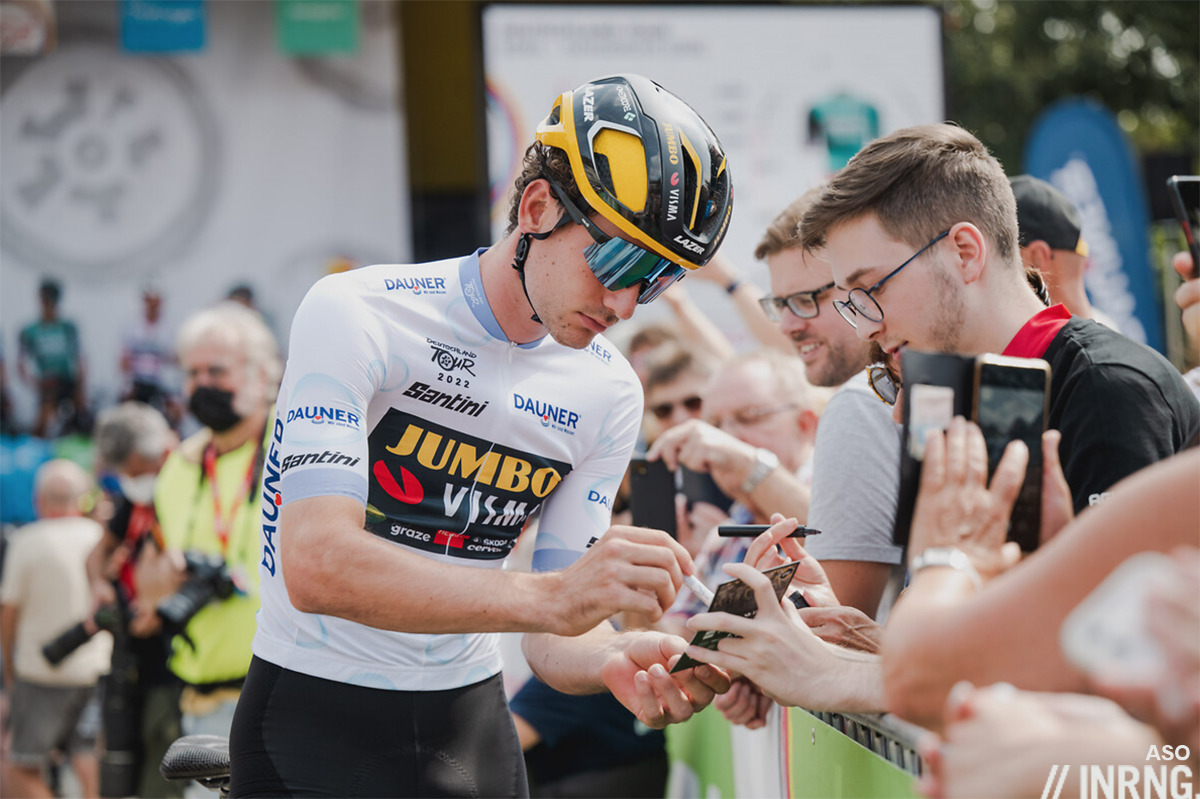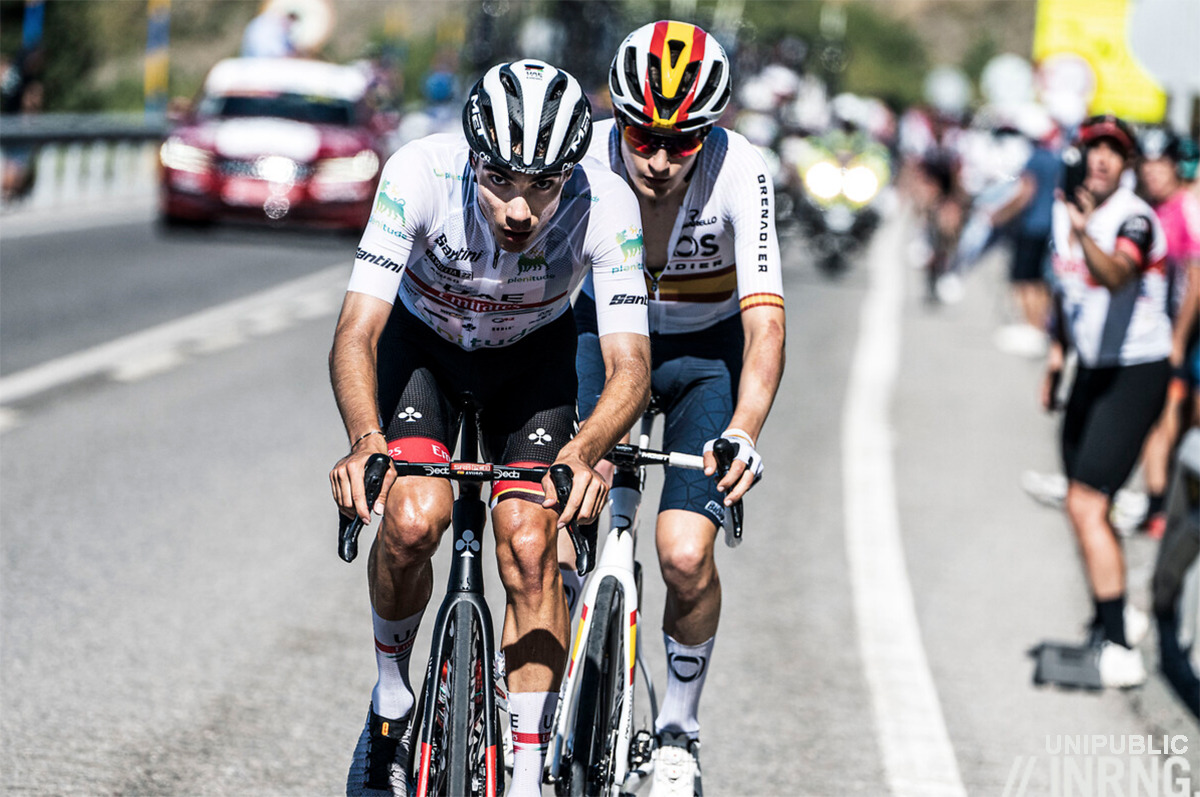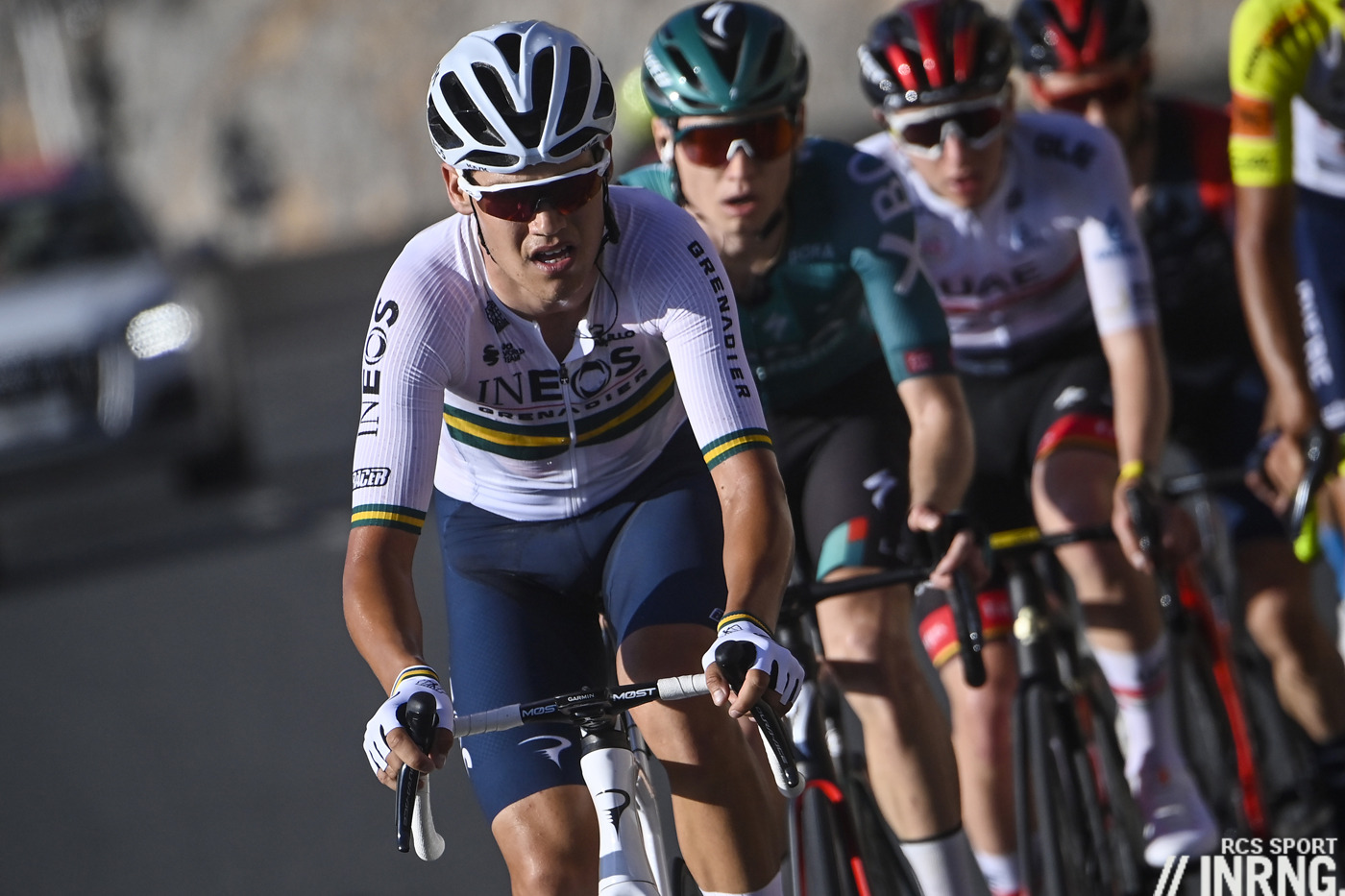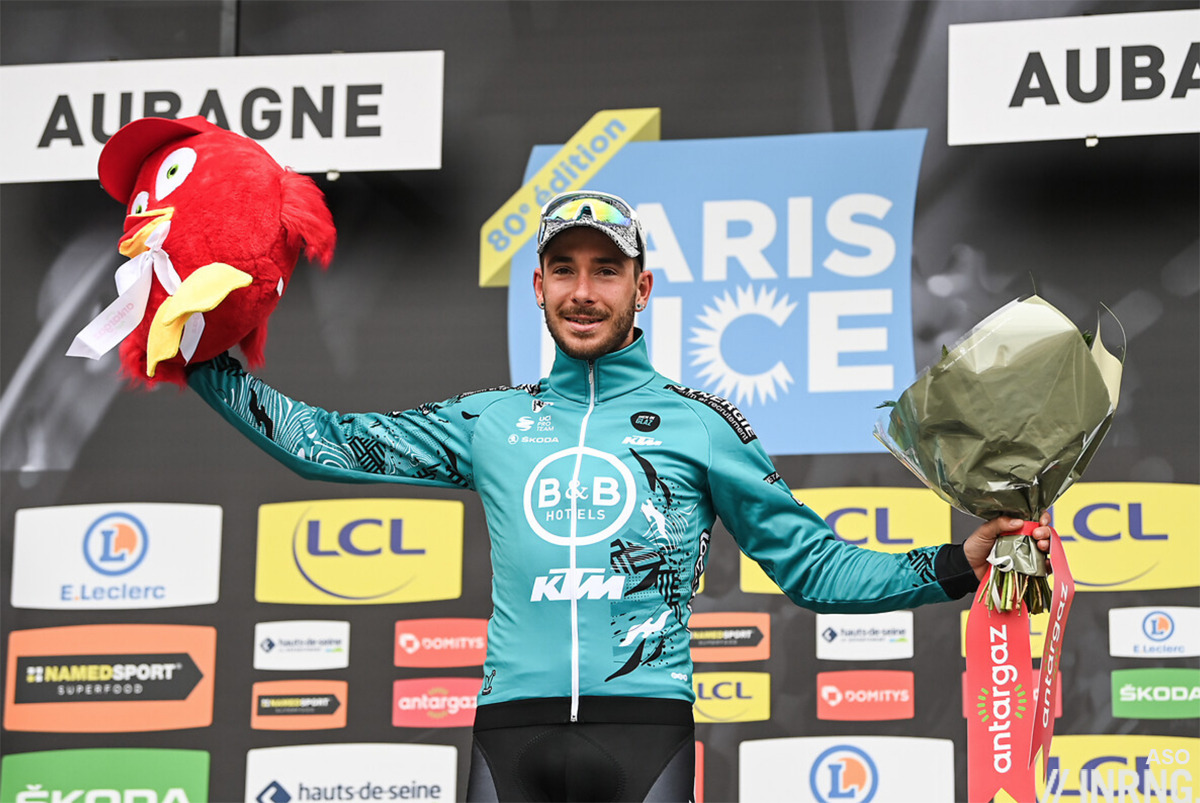Having tipped ten neo-pros to watch for 2022, time to look back and see how they fared.
Not long ago you’d look for a top-10 here or a best young rider prize there as proof of a promising debut. These days neo-pros are winning races as teenagers, making the podium in a grand tour and finishing in the top-10 on the UCI rankings but they’re still exceptions, but they certainly grab our attention.
Tobias Halland Johannessen (Uno-X) had a great 2021, winning the Tour de l’Avenir and much more along the way. His pro debut was sizzling with a win atop Mont Bouquet in February’s Etoile de Bessèges. A steady seventh place in the Volta Catalunya showed he could hold his own in the World Tour stage races and he finished tenth overall in the Critérium du Dauphiné where he took the best young rider competition, a coveted summer prize. Normally all of this would be perfect, only our reference points have been blown away by rival neo-pros, the story of placing here and winning white jerseys there used to impress – it still should – but we’ve got used to big wins. The second half of the season wasn’t as good, he’s had knee injuries before and more pain led to surgery. If he’s recovered he’ll be worth watching again on a team that’s packed with talent.

Mick van Dijke (Jumbo-Visma) didn’t get big results but he seemed to get everything right and when Olav Kooij was winning sprints, van Dijke was often launching him for the sprint. He was also influential in Christope Laporte’s overall win in the Tour of Denmark. The big result to write home about was fourth in the Deutschland Tour’s prologue where he left many big names in his wake and picked up the best young rider. He got a “rider of the future” award last year… and has just got it again this year too.
Filippo Baroncini (Trek-Segafredo) found 2022 much harder than he’d hoped. The U23 world champion crashed in February’s Volta ao Algarve and broke his arm, an unfortunate start to his pro career and if he got going again and picked up some handy top-10s here and there, he’d crash in the Bretagne Classic (ex Ouest-France Plouay), breaking his wrist and collarbone. He tells Italian website oasport that he’s learned a lot but found the transition to pro cycling a wrench, with fewer people around him but he’s ambitious about finding winning ways next year.
Marijn van den Berg (EF Education-Easypost) was one of the best sprinters on the amateur scene in 2021 but made a victory salute with his hand of talking on the phone, a “call me” for the pro teams as nobody had actually called him about a contract. EF came calling, presumably keen to have a house sprinter to boost their win rate. No wins but some placings, MvdB – to coin a name – thrived in the amateur ranks because a lighter build made him more agile but now in the pro ranks it can pay to boss one niche rather than do various roles although team mate Magnus Cort shows the way for being a lighter and crafty sprinter. In a team that needed points as well as results, he played his part as one of the squad’s top-10 scorers.
Cian Uijtdebroeks (Bora-Hansgrohe) jumped straight out of the junior ranks into the pros and the gap is huge. Measure it by distance and a long day in the junior ranks would be 100-120km, that’s doubled in the pro ranks. After the leap up, a step back of sorts to the U23 calendar where he won the Tour de l’Avenir, taking the two summit finishes, a giant result for a rider who’s still a teenager. This is where the design-feature of the development teams of World Tour squads come in, if Bora-Hansgrohe had one – they have a junior team but no U23 – then perhaps Uijtdebroeks could have ridden at U23 level during the season and joined the World Tour squad for some racing.

Juan Ayuso (UAE Emirates) technically turned pro midway in 2021 but was too good to leave out. He had a promising start in the Drôme Classic this year when he and Jonas Vingegaard rode away from the field on a climb and coming into the finish it looked like we might see Ayuso’s sprint but he cramped and the Dane won the day. Was a 190km race too much for the teenager that day? Apparently not, he coped well in the Volta a Catalunya and wasn’t supposed to do a grand tour but started the Vuelta and finished third thanks to consistent riding, he didn’t fade in the third week. He’s one of those smashing assumptions and shattering glass ceilings and its exciting to watch.
How good is Arnaud De Lie (Lotto-Soudal)? He finished the season as the sixth best rider in the world on the UCI rankings, only Pogačar, Van Aert, Evenepoel, Vingegaard and Vlasov were ahead. Not bad, but this tells us more about the way the rankings are compiled and De Lie’s race program. He’s good but not that good. As Lotto-Soudal scrapped to avoid relegation, De Lie kept them in battle, scoring more points for the team than the next three best riders on the squad combined and if it wasn’t for him the team would have had their hopes dashed much earlier. The “Bull of Lescheret” got nine wins, eight in 1.1 races, sometimes complete with bovine victory salutes. Even when he lost he impressed others, take the Polynormande race in France when the breakaway stayed clear while behind De Lie launched such a powerful sprint he put time into the bunch and the Israel team’s social media account reported their rider Biermans won the bunch sprint, not thinking De Lie could open up such a gap. The next test is to see how he can cope in bigger races although he was strong in the Bretagne Classic but perhaps too strong, launching early with the confident sprint that would see him clean up in a 1.1 race but against Wout van Aert he got schooled that day.
Georg Steinhauser (EF Education-Easypost) had a perfect start, taking the best young rider prize in this debut, the one-day Vuelta a Murcia, albeit finishing 14th. Results-wise the big achievement was the team time trial win in the Tour de l’Avenir where Steinhauser helped Germany beat the Belgians by two seconds.

Luke Plapp (Ineos) started the year as a promising time triallist. He’d started the 2021 with the Aussie TT title, beating Rohan Dennis and finished the year with a silver medal in the U23 worlds. Turning pro he expanded on this range to show he can climb with the best too, at least on long steady climbs like the Jabel Hafeet finish of the UAE Tour and he got a tidy top-10 overall in the Tour de Romandie, a podium finish in the Tour of Norway and banked the Vuelta riding in service of Carlos Rodriguez. All impressive and while learning plenty.

The tenth pick was Victor Koretzky (B&B-KTM) as a mountain biker taking up road racing, an outsider pick and, aged 28, technically not a neo-pro as it’s 25 and under. As one of the best riders on the World Cup, could he make the switch? Now riders mixing and matching is all the rage as riders move from the track to road, cyclo-cross and more but Koretzky’s different, he’d barely raced on the road (good luck finding his name in even a village road race). So just learning about road racing was a job, all the things peers take for granted like moving around a peloton or crosswinds were new. He did alright, a trip to the podium in Paris-Nice for a combativity prize and even won a stage in the 2.2-rated Alpes Isère Tour, exploiting a tricky finish to give the bunch the slip. He’s not the new Wout van Aert or Tom Pidcock but for a team in need of results and publicity, he’s done alright in his first year.
Having picked these ten in January, now comes the benefit of hindsight… other picks could have been Kévin Vauquelin (Arkéa-Samsic) but who saw him coming? Ditto Axel Laurance (B&B Hotels-KTM). People did see Magnus Sheffield coming but he as he wasn’t a neo-pro he didn’t make the list but still impressed, Ineos team mate Ben Turner did well. Corbin Strong (Israel) is one to watch. Sam Welsford (DSM) sprinted well. Axel Zingle (Cofidis) was winning and often on tough, wet days, perhaps its his background as a downhill skier… or maybe not. Daan Hoole (Trek-Segafredo) is good against the clock and solid support in the classics.


Ayuso looks like the real deal to me.
Does Kooij not qualify for this group … he seems to have a lot of success without really being heralded?
Kooij’s done well… but he’s a second year pro after signing for Jumbo-Visma in February 2021 (technically a neo-pro is a pro aged 25 or under on the first contract which is a minimum two year deal so it can be a second year rider but it’d make for a slack blog post if we discussed riders who’d already had a whole year on the road).
Agreed, I seem to recall a certain Tadej Pogacar riding to 3rd in La Vuelta in his Grand Tour debut. Will be interested to see whether Team UAE deploy him as assistance in the Tour or a leader in the Giro or Vuelta.
Ayuso’s already talking about going back to the Vuelta for the win. With Pogačar for the Tour and Almeida aiming at the Giro and these two capable of doing the Vuelta as well, leadership places for anyone else are hard to come by for their other riders but some of these riders like McNulty look essential for Pogačar in the Tour, maybe Adam Yates too.
I was thinking all the best neo professionals would be taken by Ineos, UAE and Jumbo-Vista but looks like some can start in other teams.
Interesting to read Bora have no u23 team, instead they have a u19 team.
Yes, the big teams seem to want talent early rather than just buying them when they’re proven winners, it seems easier to retain a rider rather than hire them over.
In some cases we’re seeing riders getting contracts because they want to turn pro early, I think Lotto-Soudal might have been happy to have De Lie in the U23 ranks for another year but it sounded like other teams were interested so they made him a good offer. Clément Champoussin was similar at Ag2r before, the Ag2r U23 team had lost Matteo Jorgenson to Movistar as they wanted to keep him at U23, and not wanting this to repeat had to give Champoussin a contract early. And this several times over for the Groupama-FDJ team, they ended up taking so many riders to the pro team (one or two are bound to feature in the list to watch for 2023).
“Ben Turner did well”. I think this undersells how strong he was in the Classics. If he hadn’t been working for Pidcock and Van Baarle he could have had podiums but 11th at PR is pretty impressive. He did seem to fade later in the year.
He was very visible, and not just because he’s so tall. But there’s a period where you can be all over a race in the final 40-10km, making moves here and there where many are fading away… but not be in contention for a result.
He’s a good TT rider and you can see him being deployed to pull on the plains too in a grand tour.
I hope he doesn’t become another Luke Rowe. Hugely valuable but not a win to his name
He looks better to me than Rowe. Up at the pointy end even after working for Pidcock.
Plenty top 10s for Rowe early in his career at Roubaix, Flanders, Omloop and KBK. Turner is a long way from matching that yet (as are a lot of other Classics specialists).
Suspect Rowe is stronger than people give him credit for but he’s recognised where his value at Sky/Ineos rests as a road captain and elite domestique.
But you’re comparing a neo-pro season with a career. Rowe’s first two years with Sky were bereft of any results.
Fair point.
I see him more as the new Ian Stannard. So much so I might have a sneaky punt on Turner to win Het Niewsblad next year.
IR picked out Luke Plapp and he has indeed had a decent season. I just worry that Ineos have such a strong roster that promising riders often seem to be almost forgotten among all the big names. Looking at the 2023 squad at least sixteen riders might expect some degree of support and protection in races. They’ll all get decent wages and technical support but will riders like Connor Swift and Ben Tulett get the chances they would have had in previous teams (Arkéa-Samsic and Alpecon-Fenix)?
It is hard to get a look in, even established riders there know it. One rider’s said words to the effect he he felt like he has to push to get results in smaller races in order to have a shot at leadership in a grand tour, but the fact of aiming to be in form and fighting hard in this pre-grand tour race means he can’t approach the big goal serenely, he’s spent a bit of energy just to get there. On another team he’d be guaranteed leadership.
But also Ineos pay well, Plapp would find it hard to start elsewhere even if peak earnings really should come in 5-10 years’ time. Ineos and Jumbo-Visma can pay not just to recruit riders but retain and buy loyalty, a rider might have a co-leader or helper role on the team but they’re not thinking “I’m underpaid, I need a result for myself to cash in and get that life-changing big contract elsewhere”, when this happens then you get splits, clashes and Soler-esque pulling out of earpieces in the finish of a race etc.
Rather disingenuous! How many GT leaders haven’t got results in smaller races before being given the mantle? Ineos actually seem to have given most of their young riders a chance to shine in the lesser races in the last year.
I have been mulling over where Papp will find his niche and my guess is that it might be 1 week stage races. There seems to be a bit more to him than Dennis.
Met someone at Aussie cycling earlier in the year who was saying they think Plapp is the real deal, and is a physical freak from the testing they’ve done.
I have been watching the INEOS policy of signing young riders and their subsequent progress with some interest. The first wave of youngsters have probably not reached the level expected, with one or two outstanding one off performances – TGH in the Giro.
This contrasts somewhat to Illingworth’s undoubted success with the old BC Academy riders based in Italy over ten years ago, which produced Cav and Thomas amongst a production line of many others.
I understand the reasoning behind signing up young riders, but worry about ‘burn out’ due to the sudden rise in the level of competition and the demands placed on the riders.
Kwiat gave up so many wins for the cash.
Uijtdebroeks looks the real deal. What chances a big GT start in 23, the Tour even.
https://www.velonews.com/news/road/gianni-savios-drone-hopper-squad-to-merge-with-colombian-team/
Sort-of on the subject of new talent since Savio’s found a few over the years – I post this link for those who imply that Savio’s some kind of shady crook who is getting rich from cycling.
Too many would just walk away from their obligations when the sponsor bails out https://www.velonews.com/news/road/qhubeka-nexthash-riders-missing-november-december-pay-as-uci-bank-guarantee-kicks-in/ This fellow’s new Q36.5 team should not get a license until every financial obligation from his previous program has been fulfilled. His new money-man can certainly afford this!
Anybody know what the turnover/profit numbers of the company behind Q36.5 is?
Can they really afford this, or is it going to be another “Aqua Blue” / etc.?
At the other end of the peloton: sad news about Davide Rebellin.
Even tragic, I’d say and with a greater scope than the huge human loss. Since 2017, only five years ago, Italy lost two of its top 10-15 cycling athletes of the last couple of decades because they were killed during training by reckless to criminal behaviour of drivers on motor vehicles. Tip of the iceberg, and, heck, what a tip! Pretty much sure that nobody is going to act this time, either. It’s a shame and a social plague.
Hear hear.